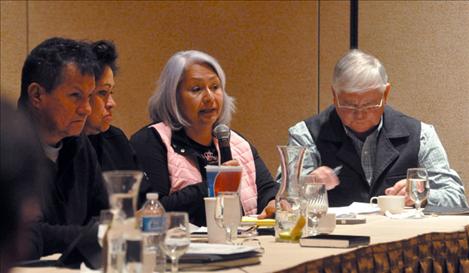Water Compact negotiations pushed to the wire
Hey savvy news reader! Thanks for choosing local.
You are now reading
1 of 3 free articles.
With a little less than a month left until the state legislature convenes, state, federal, and tribal officials met in Missoula Dec. 1 to hammer out last minute details of the Confederated Salish and Kootenai Water Compact.
Officials said they were getting closer to agreeing on most elements of the compact, which has one final chance to make it through the 2015 legislature. The compact would settle water rights claims for the Confederated Salish and Kootenai Tribes. If the compact does not pass by June 30, 2015, the Tribes will be forced to file their claims in state water court. The Tribes have said they will file as many as 10,000 claims as far east as Billings if the compact doesn’t pass.
Assistant State Attorney General Cory Swanson told irrigators in September that a compact not complete by Christmastime would suffer a severely diminished chance of passing the legislative session, and officials have pushed that deadline to the brink.
“We’re making progress,” Montana Reserved Water Rights Commission Chairman Chris Tweeten said. “We’re working our way through these issues, and that is important because time is getting short. In a month the legislature will be meeting so we don’t have much more time to burn before we finish our work.”
Officials for both the state and tribes said they have agreed that in years of water shortages, water will be made available to irrigators for $8 per acre-foot, an amount that was a compromise from the Tribe’s suggested $40 per acre-foot original suggestion, and the state’s counter proposal that the water be made available for free. A $25 fee for processing will be attached to the acre-foot amount.
The tribes have also agreed to continue the low-cost block of power that is attached to Kerr Dam if the tribes still are licensed to operate the dam past 2035. State officials say the low-cost block of power is critical to keeping irrigation project’s pumping fund afloat.
Officials said they were also closer to working out minute details in a plan that lays out the hierarchy of which water needs are met during drought years. The tribes and state have agreed that tribal in-stream flows and irrigators will bear drought through shared shortages, but the exact order of which reservoirs will and won’t be filled is something that is still being hashed out.
Both sides have also tentatively agreed to the concept of having some sort of written document that gives irrigators a right to delivery of water from the project. Negotiators have also agreed to put in place plan of adaptive management that is meant to verify that farms receive water that is comparable to historic use. Verifying the on-farm delivery has been an element of the compact that emerged after the tribes’ modeling systems came under extreme scrutiny from irrigators concerned they won’t get enough water.
Tribal Attorney Rhonda Swaney said the tribes have long-agreed that it is important to measure the water flowing through the irrigation system, but that implementation of adaptive management doesn’t mean the tribes believe their models will prove faulty.
“The tribes proposed adaptive management all along,” Swaney said. “We agree that we need to measure and take a look at whether we hit the targets that the model says we should hit. I do want to point out that the model is based on more than 20 years of data, 20 years of measurements in most of the major diversions that go into the project. While it is a model and there are components that are done scientifically and not by measurement, we have the greatest confidence in the model and the greatest confidence that historic measured diversions will meet historic on-farms needs, because they have.”
Swaney said the tribes believe the end result of the compact will likely result in irrigation project water being saved by operational improvements the tribes have agreed to fund through settlement dollars that will be part of negotiations. The exact amount of settlement dollars available to the tribes will be determined by the United States Congress.
Swaney acknowledged working through the compact has taken much time and effort, but that the parties are closer to reaching an agreement.
“I think we are very close to an agreement on principle,” Swaney said. “The devil’s in the details.”
A negotiating session will take place Dec. 10 at KwaTaqNuk resort at 1 p.m. in Polson.
















